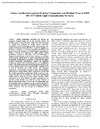Identificador persistente para citar o vincular este elemento:
https://accedacris.ulpgc.es/jspui/handle/10553/55458
| Título: | Indoor localization based on principal components and decision trees in IEEE 802.15.7 visible light communication networks | Autores/as: | Sánchez-Rodríguez, David Alonso-González, Itziar Ley-Bosch, Carlos Sánchez-Medina, Javier J. Quintana-Suárez, Miguel A. Ramírez-Casañas, Carlos |
Clasificación UNESCO: | 120304 Inteligencia artificial | Palabras clave: | Indoor localization Visible light communication Decision trees Principal components analysis Received signal strength |
Fecha de publicación: | 2017 | Publicación seriada: | International Journal on Advances in Networks and Services | Resumen: | Indoor positioning estimation has become an attractive research topic due to the growing interest in location-aware services. Research works have been proposed on solving this problem by using wireless networks. Nevertheless, there is still much room for improvement in the quality of the proposed classification or regression models, i.e., in terms of accuracy or root mean squared error (RMSE). In the last years, the emergence of Visible Light Communication brings a brand new approach to high quality indoor positioning. Among its advantages, this new technology is immune to electromagnetic interference, and also, the variance of the received optical power is smaller than other RF based technologies. In this paper, we propose a fingerprinting indoor location estimation methodology based on principal components analysis (PCA) and decision trees as classification learner. The proposed localization methodology is based on the received signal strength from a grid of emitters multiple. PCA is used to transform all of that features into principal components, consequently reducing the data dimensionality, improving the interpretability of the resulting tree models and the overall computational performance of the proposed system. Along with the proposed method, we also share experimental results derived from the received signal strength values obtained from an IEEE 802.15.7 simulator developed by our research group. Results show that the system accuracy is slightly improved by range 1%-10% and the computation time by range 40%-50%, as compared to the system in which PCA is not carried out. The best tested model (classifier) yielded a 95.6% accuracy, with an average error distance of 2.4 centimeters. | URI: | https://accedacris.ulpgc.es/handle/10553/55458 | ISSN: | 1942-2644 | Fuente: | International Journal on Advances in Networks and Services [ISSN 1942-2644], v. 10 (1-2), p. 25-34 |
| Colección: | Artículos |
Visitas
106
actualizado el 16-mar-2024
Descargas
49
actualizado el 16-mar-2024
Google ScholarTM
Verifica
Comparte
Exporta metadatos
Los elementos en ULPGC accedaCRIS están protegidos por derechos de autor con todos los derechos reservados, a menos que se indique lo contrario.
